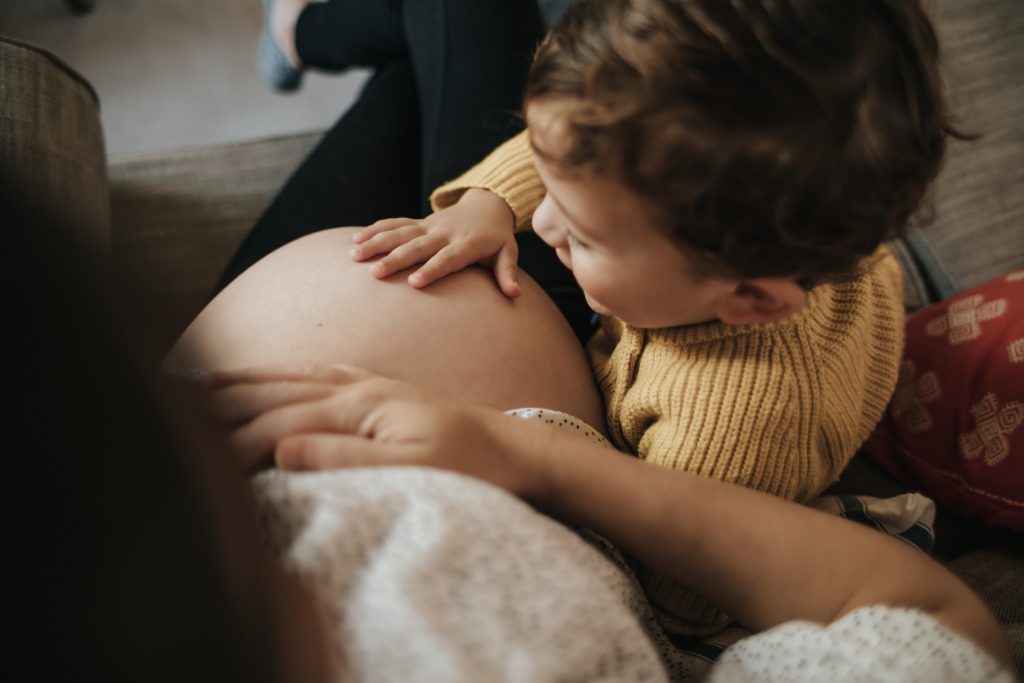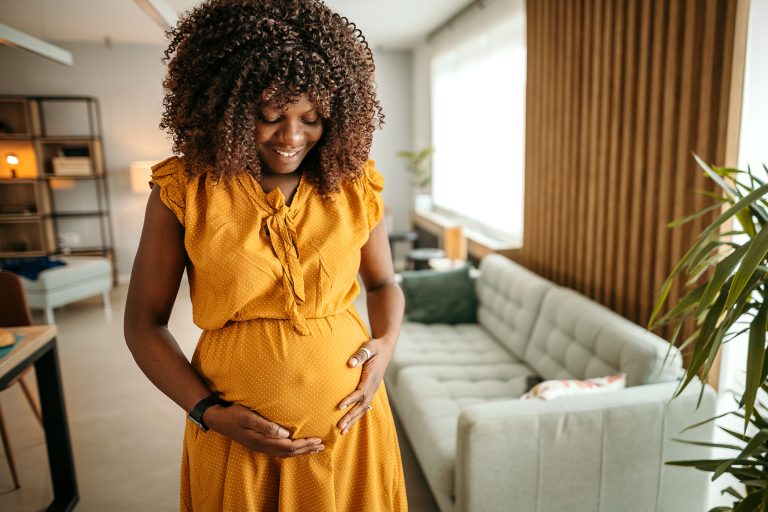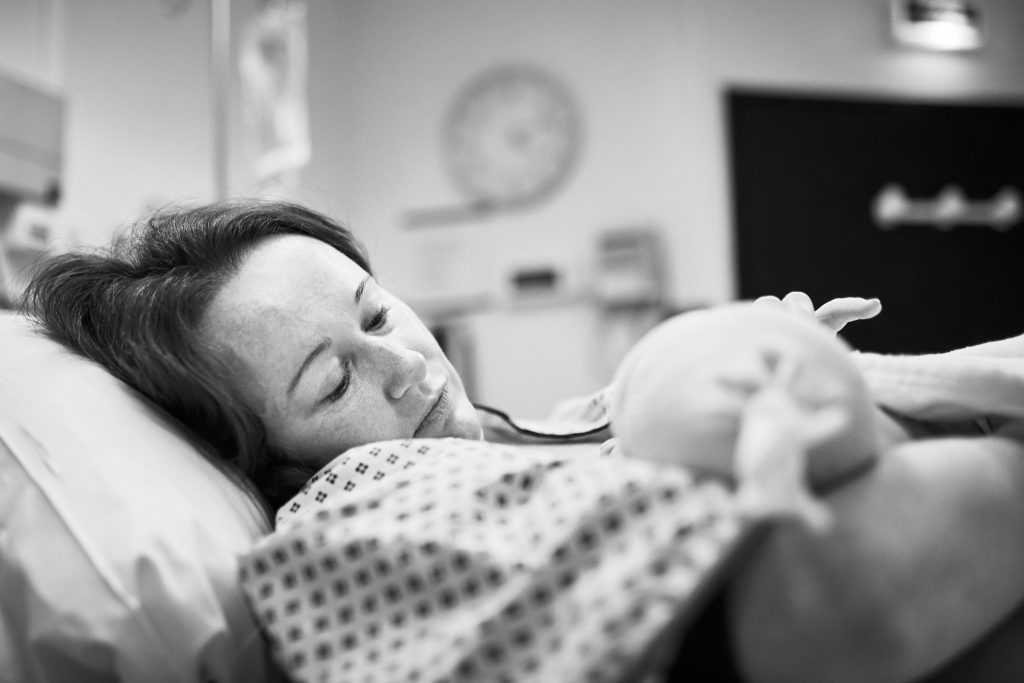Congratulations on the pregnancy. Although every pregnancy is different, there are three common stages of pregnancy, called trimesters, that pregnant persons go through during their nine months of pregnancy.
The best way to ensure a healthy pregnancy and baby is to attend regular prenatal visits with a health care provider throughout the entire pregnancy. These visits will include screenings and general health check-ups to monitor your pregnancy and baby, and will prepare you for the birth of the baby. To find a pregnancy health care provider that delivers at The Mother Baby Center near you, check out our Find a Provider tool.
Keep in mind that The Mother Baby Center does not provide prenatal care. The Mother Baby Center is where you will deliver your baby. If you have questions about your pregnancy and health care during this time, please talk directly with the pregnancy care provider and clinic.
First trimester: 0 to 3 months (Weeks 1-13)
The first trimester extends from conception to 13 weeks, covering the initial three months of pregnancy. During this period, the fertilized egg transforms from a cluster of cells into a fetus that starts to develop human characteristics.
While you may not yet “look” pregnant, your body is growing a placenta, adding breast tissue, producing amniotic fluid, and increasing blood volume all to create and nurture your baby. While this pregnancy stage is exciting, it’s also a time when many pregnant people experience physical symptoms, such as fatigue, nausea, morning sickness, breast tenderness, frequent urination, and lightheadedness.
Week 1
You’re not pregnant…yet! Conception (when the sperm fertilizes the egg and you become pregnant) usually happens about two weeks after the beginning of your last period.
Week 2
You’re ovulating. Your egg matures in an ovary. When it is released, it is swept up by the fallopian tube.
Week 3
Your egg is fertilized by sperm. The fertilized egg divides, and the cells multiply and form a ball. The cluster of cells travel down the fallopian tube into your uterus.
Week 4
You missed your period and if you took a pregnancy test, it most likely showed that you are pregnant! The cluster of cells attach to your uterus. Then, nourished by the blood supply to your uterus, the cells begin to form the baby and the placenta.
Week 5
Your baby’s nervous system, spine and brain are developing. Baby is one tenth of an inch long.
Week 6
Your baby’s heart is developing in the chest cavity and now has two chambers.
Week 7
Your baby’s eyes and ears are developing. His or her brain and spinal cord are almost fully developed. Your baby’s heart now has four chambers and is beating strongly enough to circulate blood.
Week 8
Your baby’s eyes and inner ears continue to develop. Baby can open his or her mouth and suck. All major internal organs are now in place but are not yet fully developed. Your baby is about 1 inch long and weighs less than 1 ounce.
Week 9
Your baby is starting to kick, although you won’t be able to feel it yet. Baby’s chest cavity is separated from abdominal cavity by a muscle that later becomes the diaphragm.
Week 10
Your baby’s umbilical cord is formed and blood is circulating in it. Baby’s head is still large in proportion to his or her body.
Week 11
Your baby’s head is nearly half the size of your baby. All essential internal organs are formed and most begin to function. Baby’s external genitalia are developing.
Week 12
Your baby is practicing breathing movements. His or her vocal cords are starting to form.
Week 13
Your baby is completely formed, is 3 ½ inches long, and weighs about 1 ounce.
First Trimester To Do List
- Rest, eat well and take care of yourself.
- Check your insurance coverage. Find out exactly what is and isn’t covered under your plan. The worksheet determining your health insurance coverage can be of help when you call your health plan.
- Check your employer’s policies on maternity leave. You may have disability or extended leave benefits. What is the policy on paid leave? How many weeks can you take off without pay? What is the policy on job security?
- Talk with family members or friends about their breastfeeding experiences and what they like best about breastfeeding.
- Download a free mobile app of this information.
- Register for a variety of prenatal classes. Learn more about our birthing classes here.
- Arrange your first prenatal appointment
- Double check your medications
- Start taking a prenatal supplement
- Stay active and consider your diet
- Prioritize your sleep
- Be prepared to battle morning sickness
- Join local clubs for new and expecting mothers
Get more information with our first trimester checklist.
When is the baby due? Calculate your due date.
Preparing for your first prenatal visit? Find out about what to expect and questions to ask at your first prenatal visit.
Learn more about home health care during pregnancy (antepartum). Some families need extra medical care during pregnancy in addition to their clinic visits. Depending on the situation and needs, many patients benefit from having an Allina Health Home Health – Mother and Newborn nurse provide care in their homes.

Second trimester: 4 to 6 months (Weeks 14-26)
The second trimester of pregnancy is often considered the most enjoyable phase. By the fourth month, you will likely feel less nauseated and energy levels will return. It is during this time that the pregnancy will likely become more visible to others and may find that your regular clothes begin to feel uncomfortable. During the second trimester, it’s not uncommon to have heartburn, indigestion, and constipation. Other discomforts may include varicose veins, hemorrhoids, breathlessness, and leg cramps.
You might also begin to feel your growing baby move as it flips and turns in your uterus. During the second trimester, many people learn the baby’s gender, usually during an anatomy scan—an ultrasound that assesses physical development. However, some babies don’t provide a clear enough view during an ultrasound to tell for sure.
Week 14
Your baby’s hair and eyebrows are growing. Their heartbeat is strong enough to hear with ultrasound.
Week 15
Your baby’s middle ear bones have harden, so they can hear.
Week 16
Your baby’s skin is now covered with a fine, downy hair called Lanugo. Baby’s external genital organs (girl or boy) are developed enough to be seen with ultrasound. Your baby’s gender can be identified in the fourth month. However, some babies don’t provide a clear enough view during an ultrasound to tell for sure.
Week 17
Your baby can hear and respond to sound. Loud noises may startle your baby making them move. Your baby is listening to your voice and will recognize it after they are born. They will recognize the voices of other family members, too
Week 18
Your baby is about 8 inches long and is moving much of the time now. They can kick their legs, move their arms, turn their head, and suck a finger or thumb. Your baby’s fingernails and toenails also begin to appear.
Week 19
Your baby is swallowing amniotic fluid, the fluid that surrounds them, and passing it as urine. Baby may get hiccups. Buds for permanent teeth are beginning to form.
Week 20
You’ll probably feel the first flutters of your baby’s movements. This is called quickening. Your baby is about 8 1/2 inches long and weighs 8 to 16 ounces.
Week 21
Your baby’s skin is becoming opaque. Their tongue is fully developed.
Week 22
Your baby’s skin becomes covered with a protective, white coating called vernix. Most of the vernix will disappear before birth.
Week 23
Your baby’s heartbeat might be able to be heard with a stethoscope.
Week 24
Vital organs are developed enough for your baby to survive outside the womb. Lungs are immature, however, and your baby would need breathing assistance if born now.
Week 25
Your baby’s bone centers are beginning to harden.
Week 26
Your baby’s body fat is beginning to form.
Second Trimester To Do List
- Read more about breastfeeding and talk with your partner about how you will feed and nurture your baby.
- If you will be returning to work outside your home, start looking for daycare.
- Fill out and send in the preregistration form you received.
- Get a record of your vaccinations.
- Take childbirth, breastfeeding or parenting classes.
- Register for childbirth, breastfeeding or parenting classes. Learn more about our birthing classes here.
- Watch a series of short videos on how to manage pain before, during and after birth.
- Learn about relaxation for calming your busy mind.
Get more information with our second trimester checklist: nurturing your pregnancy.

Third trimester: 7 to 9 months (Weeks 27-40+)
During the third trimester, your growing baby and growing uterus decrease your mobility. This may mean that you will need to cut back on some of your activities. It may also increase some of your discomforts. You may have to be creative to find comfortable positions during the day and at night. You have an increased awareness of your developing baby. Now is a good time to start talking, reading or singing to your baby.
The third trimester is a time of steady growth as your baby matures and gets ready for birth. As your baby gains weight, fat is stored under the skin. This smooths your baby’s skin and makes your baby look plumper.
During the beginning of the third trimester, you may feel plenty of kicks, squirms, flips, hiccups and other movements in between quiet periods. Your baby starts having regular sleep and wake cycles, and you will notice the difference in activity. You may also notice your baby responding to bright light as well as sound.
The last three months of pregnancy may bring some discomfort as the baby continues to grow and develop, stretching and moving more to find room in the increasingly cramped uterus. When the third trimester begins, the pregnant person will likely see their health care provider every other week until 36 weeks, when they will likely be seen on a weekly basis.
Week 27
Your baby’s hair is longer. Their eyelashes and eyebrows are very noticeable now.
Week 28
Your baby is also opening and closing their eyes and reacting to light. Your baby is about 2 pounds and is about 13 inches from crown to rump.
Week 29
Your baby will gain about 7 ounces each week. They can kick, stretch and make grasping movements
Week 30
All of baby’s senses are developed. Your baby starts having regular sleep and wake cycles, and you will notice the difference in activity.
Week 31
Vernix (a white coating on the skin) and lanugo (the fine hair that covers the baby’s body) begin to disappear. Baby’s head is more in proportion to the body.
Week 32
Your baby’s skin is less wrinkled. They are about 18 inches long and weighs about 5 pounds.
Week 33
Most babies have moved to a “head down” or cephalic position in the uterus by this time, and most will stay in that position until delivery.
Week 34
Your baby’s skin is becoming pinker and they are blinking.
Week 35
Your baby’s fingernails and toenails have grown to the end of their fingers and toes.
Week 36
Most of your baby’s organs are now mature and the lungs continue to mature. Your baby’s skin is red but smooth. They are about 19 inches long and weighs about 6 pounds.
Week 37
As your baby gains weight, fat is stored under the skin. This smooths your baby’s skin and makes your baby look plumper.
Week 38
Your baby gains about 1 ounce each day. They may move down into your pelvic area.
Week 39
Your baby is fully developed. They are about 20 inches long and weigh 7 to 8 pounds. Fine hair remains only on arms and shoulders. Fingernails are now beyond the ends of fingertips.
Week 40
It’s your due date! Your due date is only an estimate for when your baby is likely to be born. Most babies are born between 37 and 42 weeks.
Third Trimester To Do List
- Keep track of your baby’s activity.
- Identify who can give you breastfeeding support, such as a family member or friend. If you don’t already know, find out what breastfeeding services your hospital offers.
- Buy several nursing bras. Choose cotton cups that are not lined with plastic and two extra clasp-widths for expanded comfort. The last three weeks of pregnancy are the best time to schedule a nursing bra fitting.
- Check with your insurance company about coverage for a breast pump if you will be returning to work while you’re still nursing.
- Get the labor bag and travel bag ready.
- Review the preparing for your baby to do list.
- Talk with your health care provider about your birth plan.
- Pre-register online if you haven’t already done so.
- Register for childbirth, breastfeeding or parenting classes. Learn more about our birthing classes here.
- Watch a series of short videos on how to manage pain before, during and after birth.
- Ask your health care provider if a water birth is an option for you.
Get more information on our blog with our third trimester checklist: preparing to welcome your baby.

Fourth trimester: 12 weeks after birth
The first twelve weeks after the baby is born are referred to as the “fourth trimester”. Your body and mind are still experiencing an immense amount of changes related to birth and the delivery experience. This can be a vulnerable time for new parents. You may feel emotional changes or experience postpartum depression, in addition to the exhaustion and stress associated with caring for a newborn. Be sure to lean into your support system in these early weeks as your family finds their new routine. To learn more about emotions after delivery, please click here.
If you are having thoughts of suicide, or harm, please call 9-1-1.
